
Using a first-year method book is an obvious one. It helps you manage the almost impossible task of starting tiny little people, with tiny little fingers and huge minds full of curiosity, on their very first steps of musical discovery. Videos of professionals showing some of the basic techniques can help you start them off right, and may remind us of tips we’ve forgotten over the years.
Learning to make sound and progress in a logical way through the introduction of new notes and new rhythms and a whole new language of musical notation are all incredibly wonderful reasons to use a beginning method book.
How about after that first year? How many of you start book 2 and never finish? It’s ok, you can tell me. I bet the reason you might stop is stated above, namely a lack of time and the fact that you are using your music as the instructional material.
Taking Methods Further
It is no secret, (at least I hope it isn’t!) that I am a co-author of three method books focused on ensemble development, so I have a biased opinion. With that said, I believe using a method book as part of your curriculum throughout elementary, middle, and high school can truly unlock hours of rehearsal time. I believe using the right method book can help you teach your students to become self-corrective, understand the “how-to” questions and allow you to get to the dream of musical content much faster and more effectively.
In no way am I suggesting you buy a book, start with number 1 and go through number 412 (yes, one of the books I am part of has 412 exercises!) and voilà you’re done. To facilitate an amazing band, one that goes far beyond the basic understanding of the notes and rhythms, students need to experience introspective, deep, and meaningful performances.
The fact is YOU are the key to making those meaningful moments come to life. Using a resource book can help you deliver instructional concepts to your students by providing exercises designed to help you focus on musical concepts/skills, so you are better able to spend rehearsal time focused on making a connection between music and our souls.
What If?
Think about it, if you didn’t have to spend as much of your rehearsal talking about matching pitch, how much class time would you gain on the literature? For an example of how a method can reduce this time, check out this “Passing the Tonic” lesson plan from Sound Innovations Ensemble Development for Young Concert Band.
Similarly, what if you didn’t have to take as much time talking about scale patterns of a run? Or about making dynamics heard and how to achieve a balanced ensemble sound?
Think about how many minutes of each class you gain back to focus on musical nuance and emotional content. If we were to spend the first ten minutes of each class focused on developing your students’ ensemble skills, you will gain that time back tenfold when you are rehearsing your literature.
When your students are more fluent with how to perform in tune, with great tone and with technical facility, you can engage them in the deep and artistic concepts present in the literature. You could even rehearse ensemble skill exercises in between selections of literature for the day. The key is to isolate and work on specific ensemble skills, then apply them in the literature making a direct connection with the skills they are developing.

Playing the Percentages
If you use a resource that supports teaching beginning students ensemble skills (like Sound Innovations Ensemble Development for Young Concert Band), and continue using appropriate resources in middle and secondary schools, think how far they will go when they graduate high school or college! Think about how fulfilling it would be as a teacher to be able to explore emotion through music with your students 80%-90% of the year, rather than hanging on for dear life getting them to perform close to the right notes at close to the right time at close to the right volumes for 80%-90% of the year and really only feeling the exhilaration of performance and connection maybe twice a year at a concert.
I would suggest you and your students can experience that excitement, connection and accomplishment with the inverse ratio – 80%-90% of the time you are able to help students connect with their music and achieve the intangible feeling live music performance gives us. Using a method book that supports student learning of specific ensemble skills, like Sound Innovations Ensemble Development, and using lesson plans like “Listening vs. Hearing,” you will be able to focus many more of those precious minutes in your class helping students make a deep connection with their music. Students will be quicker to recognize playing ‘in tune’ and with balance, with technical precision, while accurately performing articulations and audible dynamics, because you have prepared them for it.
In our rehearsal rooms, every day, we have an opportunity to make magic happen. And yes, using a method book appropriately (as you determine) can unlock hidden time, by having your students learn to be responsible for fixing the things that you (and I) spend so much time on. That kind of instruction goes far beyond year one, or year two, or year three.
How to Pick a Method
Ok, ok but there are so many! How do I choose? By studying them. Get a copy. Talk to other directors. Talk to the authors (we are available) for some insight – hundreds and hundreds of hours go into designing, planning, writing, and editing just one book.
Most importantly, believe in your decision and plan, plan, plan on how to use it. Method books are a starting point and can absolutely provide you with guidance, however only you know what will work with your particular teaching situation.
Just like picking literature for your band, choosing a method is very personal. You are the professional. Evaluate your program, your students’ needs, your needs, your plan/curriculum and go from there. Using a method book from the opening of the case until the day of graduation (high school and/or college!) can truly help you gain hours of rehearsal time where you can focus on making music together!
EDITORS NOTE: Check out this related post, “3 Ways to Include Your Method Book in Lesson Plans.”
